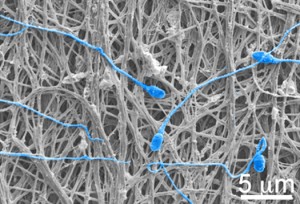According to Trojan, states were scored on two measures of safer sex: sexually transmitted diseases (STDs) and contraception. For STD rates, HIV, gonorrhea, and syphilis rates per every 100,000 citizens was examined, as well as the percentage of adults in the state who reported ever receiving an HIV test.
Tag: HIV
Depo-Provera May Hike HIV Risk in Women
Increased rates of HIV infection were seen among women using depot medroxyprogesterone acetate (Depo-Provera or DMPA), whereas other methods of contraception including oral contraceptive pills or norethisterone enanthate (Net-En, an injectable progestin steroid) did not, according to a new meta-analysis.
Can You Imagine a World Without Condoms for Safe Sex?
Currently, women who want to both avoid an unplanned pregnancy and prevent HIV and other sexually transmitted infections (STIs) have no choices other than the male or female condom. But there are new forms of female-focused methods in development that combine contraception with the prevention of STIs – including HIV – and they’re called Multipurpose Prevention Technologies (MPTs). Public health leaders expect that they will change the face of women’s global health.
Dissolving Tampons Deliver HIV Drugs (and Maybe Contraception, Too)
University of Washington researchers have come up with a whole new way to deliver HIV-killing microbicides: a dissolving tampon.
As Mixed-Status HIV Couples Weigh Risks, More Choose to Conceive the Old-Fashioned Way
When Susan Hartmann got married, she and her husband knew that they had to be careful. Given that she’s HIV-negative and he’s HIV-positive, they had to be vigilant about protected sex. But later, they decided they wanted to start a family.
New Device Provides Long-lasting Protection Against HIV and Pregnancy
An intravaginal ring that slowly releases an antiretroviral drug and a contraceptive has the potential to protect women from HIV, herpes and unwanted pregnancy.
Cervical Cancer Could be Prevented with an HIV Drug: Tablet Kills the Virus that Causes the Disease
Cervical cancer could be prevented by a commonly-used HIV drug, scientists say. The medicine has been shown to kill-off the human papilloma virus (HPV) that leads to cervical cancer.
Budget Sequester Squeezes Scientific Research
A year ago, Yuntao Wu was on a roll. The George Mason University researcher had just published a study hailed by the scientific press as “groundbreaking” that reveals why HIV targets only a specific kind of T-cell and, separately, found that a compound in soybeans seemed to have promise for inhibiting infection.
Nano-fabric defends against HIV and sperm
 U. WASHINGTON (US) — Scientists have developed an electrically spun cloth with nanometer-sized fibers that can simultaneously prevent HIV and offer contraception.
U. WASHINGTON (US) — Scientists have developed an electrically spun cloth with nanometer-sized fibers that can simultaneously prevent HIV and offer contraception.
As reported in PLOS ONE, the cloth can dissolve to release drugs, providing a platform for cheap, discrete, and reversible protection.
“Our dream is to create a product women can use to protect themselves from HIV infection and unintended pregnancy,” says corresponding author Kim Woodrow, assistant professor of bioengineering. “We have the drugs to do that. It’s really about delivering them in a way that makes them more potent, and allows a woman to want to use it.”
Electrospinning uses an electric field to catapult a charged fluid jet through air to create very fine, nanometer-scale fibers. The fibers can be manipulated to control the material’s solubility, strength, and even geometry. Because of this versatility, fibers may be better at delivering medicine than existing technologies such as gels, tablets, or pills. Read full article.
Really? That’s Amazing!!
by Ken Mosesian
Really? That’s amazing!
That’s the number one response we received from physicians when we discussed our outreach program to men living with HIV. The message is simple and extraordinary: with proper care, men living with …